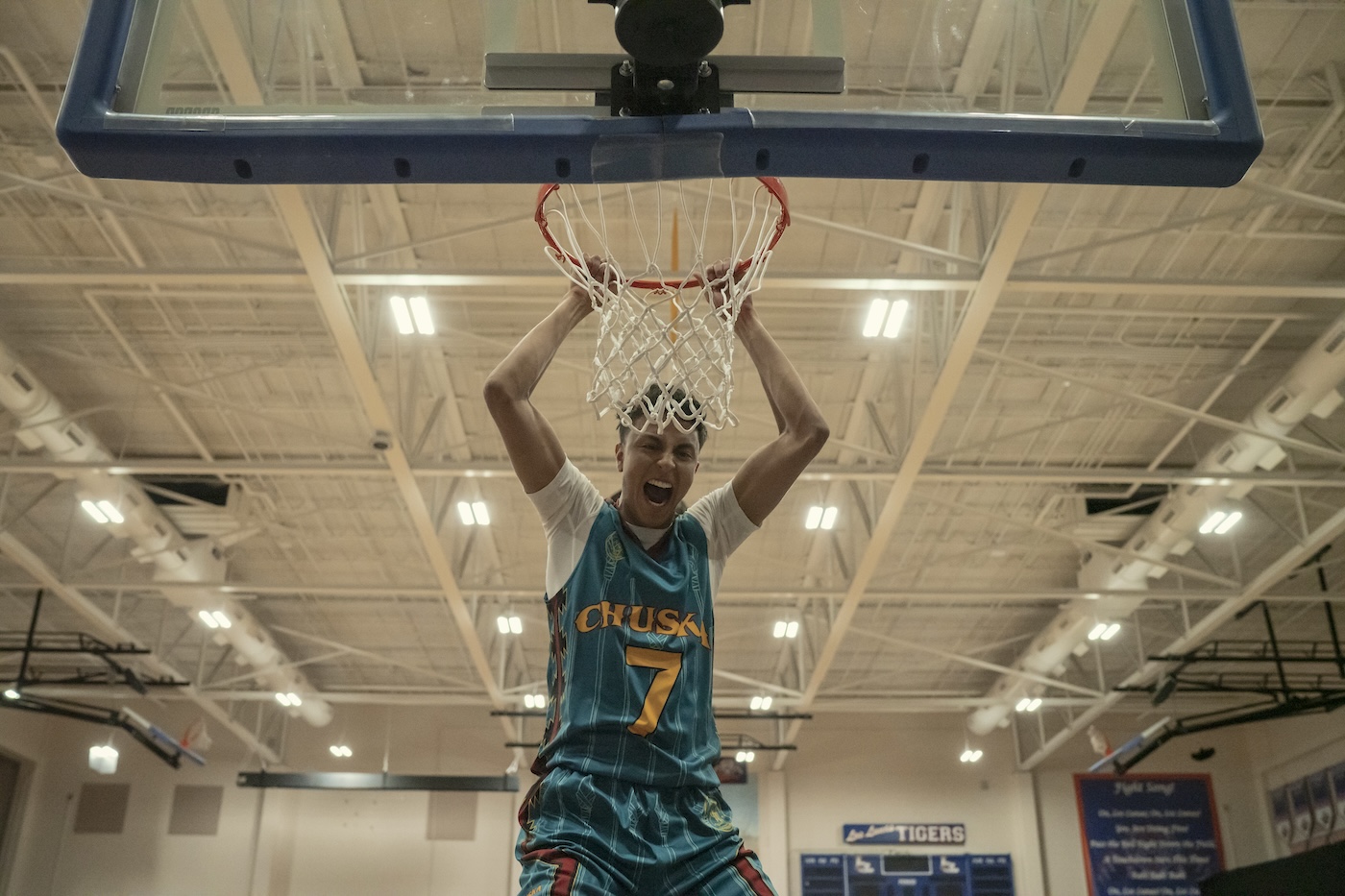Kira Kelly, ASC, hits the hardwood for Writer/Director Sydney Freeland’s personal tale of hooping life on the reservation.
by David Geffner / Photos by Lewis Jacobs / Netflix
The opening moments of the new Netflix feature Rez Ball, directed and co-written (with Sterlin Harjo) by Sydney Freeland, and shot by Local 600 Director of Photography Kira Kelly, ASC, feel familiar enough, albeit in a world rarely visualized in cinema. After several sweeping anamorphic frames of New Mexico’s vast high desert, we see Nataanii Jackson (Kusem Goodwind), a star player for the Chuska Warriors, leading his high school basketball team to victory. His brilliance on the hardwood is supported by easy-going Jimmy Holiday (Kauchani Bratt), the Robin to Nataanii’s Batman. They’ve been hooping together since they were kids, with Jimmy always the one eager to pick up Nataanii, who lost his mother and sister in a drunk-driving accident the previous year. When we see Natannii and Jimmy after a game, hanging out on a mesa high above their homes, the clear, cool-blue night enveloping their dreams, it feels like these two talented athletes may one day escape the struggle that is life on a Native reservation.
That is, until the following night when Nataanii fails to show up for Chuska’s big match-up against Santa Fe Catholic, the state’s best team with the state’s best player, Mason Troy (Sam Griesel), a towering white kid whose rim-rattling dunks and trash talk show little respect for the Chuska rez ballers. Without Nataanii, Chuska’s coach, Heather Hobbs (Jessica Matten), a one-time baller who has returned to coach her high school team, urges Jimmy to take on a starring role. The game opens with a compelling oner behind the Chuska players as they run out from the tunnel to take their home court. But, sadly, without Nataanii, the rez ballers are over-matched, getting washed by 70 as the game’s final seconds approach. When Troy is charged with a flagrant foul and ejected from the game, Jimmy takes to the free-throw line for some meaningless points. In a wide shot, as Jimmy gazes at the rim, we see Chuska’s assistant coach walk over to the bench accompanied by two uniformed Native policemen. The AC whispers to Hobbs as the gym falls into a nervous silence. The unimaginable has happened – Nataanii has taken his own life.
This intense opening act sets the table for a story of loss, grief and redemption for many of the characters who call the reservation home. Freeland, who grew up on a New Mexico reservation, drew from personal experience in creating a film that uses sports and communal identity as a metaphor for overcoming the worst life throws out. After scoring with indie festival hits like Deidra & Laney Rob a Train and Drunktown’s Finest, Freeland has racked up plenty of TV credits (Reservation Dogs, Rutherford Falls, P-Valley). Her first teaming with Kelly was on the Marvel TV series Echo, which was centered on a female character with Native roots. The budget and schedule for Rez Ball, along with the limitations of shooting on Native land, took both filmmakers back to their indie days.
I had the chance to get Kelly and Freeland (who was on her way to the film’s first reservation screening) on a Zoom together for ICG Magazine’s October Web Exclusive to learn about this one-of-a-kind experience.
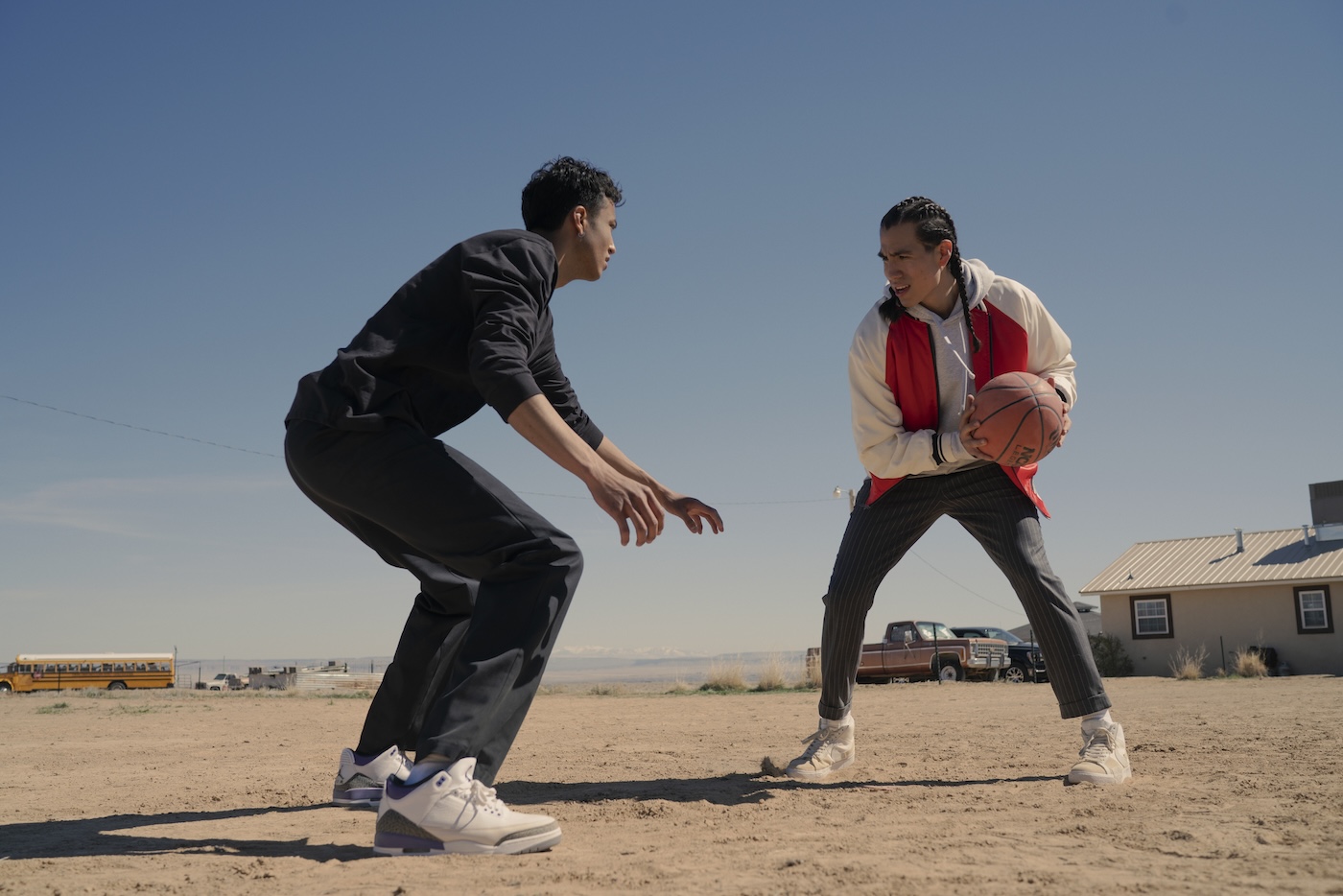
ICG: This is your second project together after Echo, and I’m sure the challenges were different.
Sydney Freeland: Rez Ball was greenlit before Echo, in 2021. We had gone to New Mexico and begun scouting and prep, and then the Delta variant [of COVID-19] hit, and we had to shut down. That ended up going right up against the start of the Marvel project, so immediately after, we started Rez Ball. Although we don’t have a deep history, Kira and I had 62 days on Echo and 29 days on Rez Ball. I’ve told her we need to get to 100 days. [Laughs.]
Why did you want Kira to help you tell this story?
SF: In our initial conversations, she understood what I was going for. I am not a cinematographer, so I speak in terms of emotions, feelings, color, and things like that. And Kira would send me films from other stills to help me visualize those ideas. It became this kind of “yes and…” dialogue, and that was our jumping-off point. Film is a collaborative medium, and Kira has an inspired way of looking at the world. I’ll sit with a scene, going back and forth over all the possible ways to approach it, and then she’ll walk up and say: “What about this?” And it’s something I never even imagined! An example of that from Rez Ball is when the team goes on a winning streak. The traditional sports montage, right? Kira had this idea to paint each side of center court with the logo from a different team, and through VFX, we could have our team play more than one game in the same shot. It was an in-camera montage that had everything I love – it was practical, it was tactile, and it pushed the story forward in an inspired way.
You both have done a lot of work in episodic TV, so you’re no stranger to compressed schedules. But 29 days sounds generous for a feature of this size.
SF: It sounds like a lot of time, but we shot 11 different basketball games, and ten days on the schedule were set aside for those scenes. That leaves 19 days for the narrative portion of the film, which typically gets compressed anyway by unforeseen challenges. Like everything, you start with ambitious ideas and then scale back when reality sets in. [Laughs]
KK: We also had limits on our shooting hours. Most days we’d have to absorb travel time in our shooting day, so Sydney would only have 10 hours of shooting, and when we were shooting on the reservation, that became seven to eight hours a day. The time went quickly.
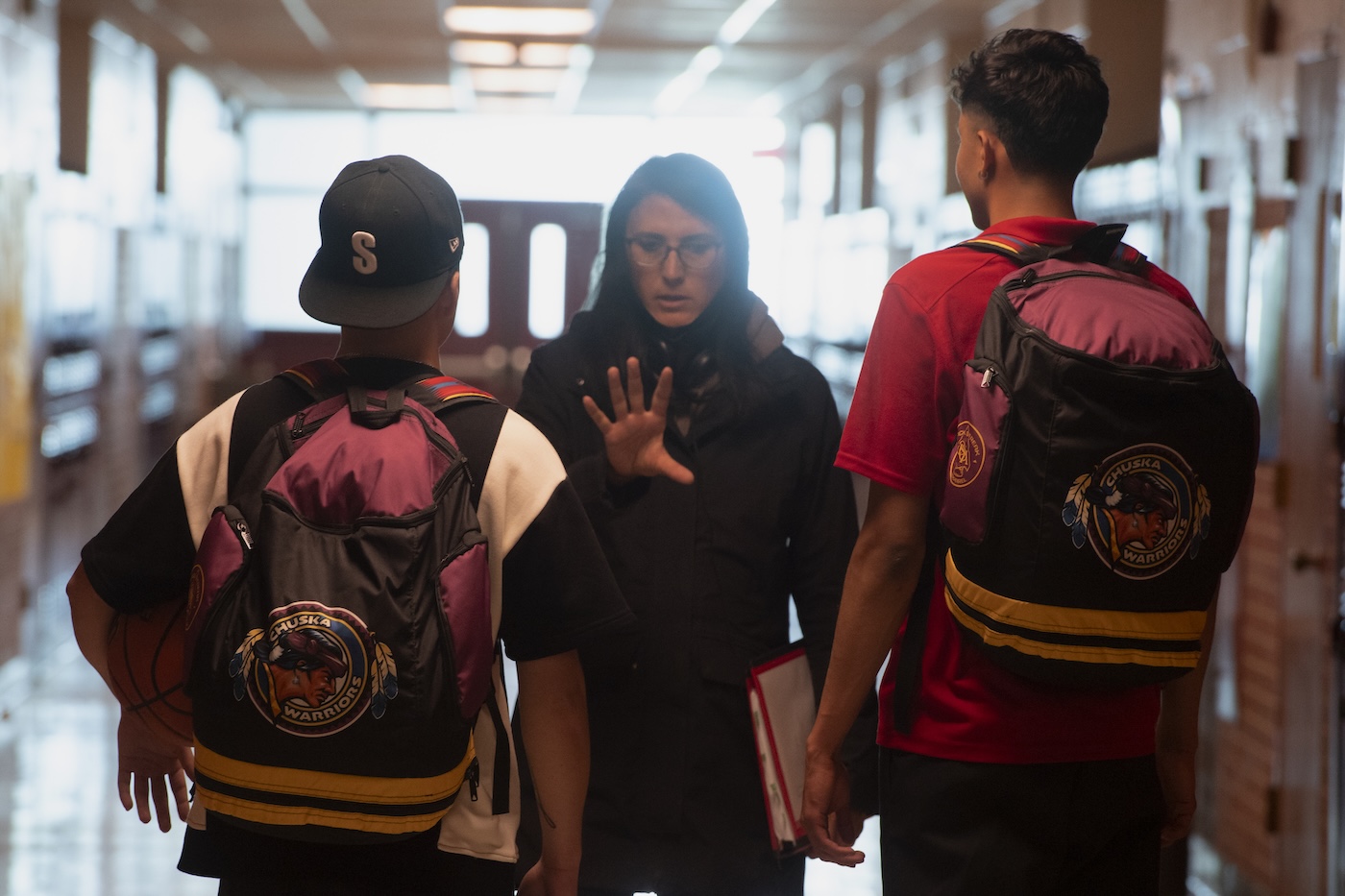
We recently covered Winning Time and Clipped, both of which had a distinct approach to shooting basketball. What did you talk about going in as to how best to portray the on-court action, as there is a lot of it?
SF: I’ll touch first on casting. We put out a call for kids to submit audition tapes that also had to show them doing three basketball drills – shooting a free throw, shooting a layup, and shooting a three-pointer. We thought that would weed people out, but we got 5,000 submissions for ten roles! Ultimately, from that, we found our 10, including our lead role [Jimmy] in Kauchani Bratt, who was fantastic. Doing that work up-front – getting actors who could also play – meant we didn’t have to bring in doubles or change framing to hide things. We could set the shots how we wanted.
Was there a single coverage default with so many games?
SF: In most games, we started with a wide tracking shot along one sideline, and then came in for coverage from both sides. That got us 95 percent of what we needed. For isolated moments, like when they start calling plays in [the Navajo language], or for the championship game, we wanted to elevate the coverage, but within our time constraints. I came across this YouTube series called “VFX Artists React,” which had done a breakdown of the Zack Snyder film 300, with these over-cranked tracking shots. They had a simple concept – place three cameras: a wide, medium, and a close-up, right next to each other. They all film the same tracking shot that is then digitally stitched together. It allowed us to both slow down time and punch-in and punch-out to emphasize a specific emotional beat or story point. Kira made all that magic happen.
Kira Kelly: I remember when Sydney mentioned the idea in prep, and I was like: “Yes, we can do this,” and it became a big part of our camera test. First AC Ethan McDonald and Key Grip Rudy Covarrubias, who did Echo with me as well as another movie, are both very talented people, and they were key to this approach. Rudy built a platform for the three cameras, and Ethan set up all the lensing. Then seeing what VFX Supervisor [at ILM] Andrew Roberts was able to do with the digital stitching convinced us it would work. Sydney uses it sparingly throughout the film – like in the first game where we realize these kids can play. It slowed the action and sucks you in; so as an audience member you’re better able to track the ball and experience what each character is doing in the story “within the story.” There’s no worry about losing critical focus, since each camera holds its own focus. We were at 120 frames per second for each lens, except for one game we shot at 96 frames because the gym was so dark.
Just one operator for three cameras?
KK: Right. Justin Browne was our A-camera/Steadicam operator, and he would pick the tightest camera and follow the ball, while the three different ACs would pull focus for each camera.
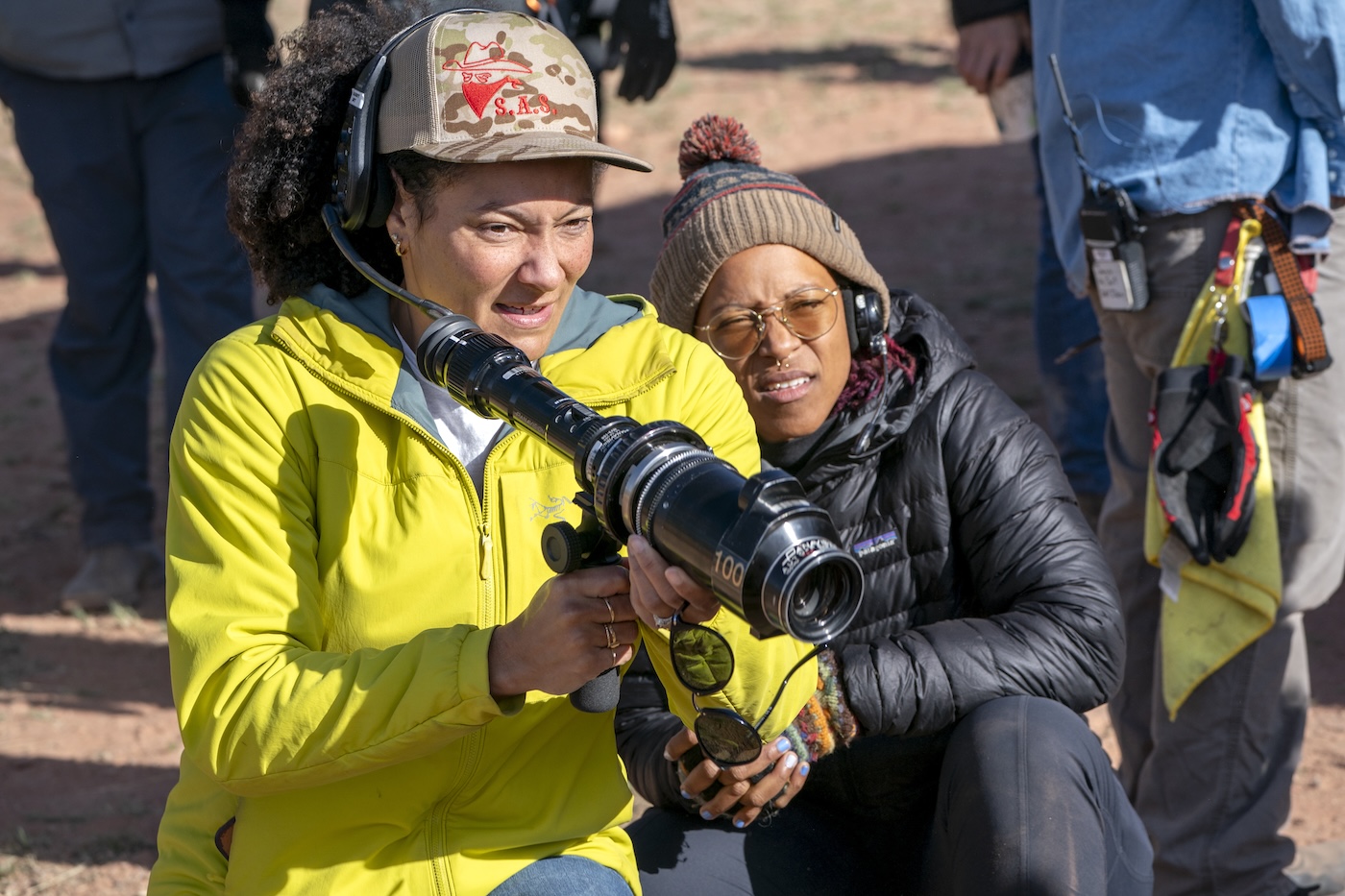
Are you shooting at multiple gyms for each game, or dressing one gym to look like a lot of different locations, as in Winning Time?
KK: We shot at multiple gyms, with the playoffs all taking place at The Pit in Albuquerque. The Chuska home gym was shot at the Santa Fe Indian School. We moved around quite a bit. We had Mike Fisher as our basketball consultant, who also played the coach of Santa Fe Catholic in the championship game. Mike set all the plays in advance and made sure all of our actors on each team knew exactly what the action would be. When we had time, we sent our operators to learn the plays in advance, but that wasn’t always possible with the schedule, so they’d have to learn them in the rehearsal. Usually, we’d have B and C cameras on a dolly, on track, on the same side of the court with A behind the basket as well. We’d run it a few times, then tighten the coverage, and have the A-camera get onto the court for whatever close-in footage we’d need. We were also able to fly out John Lyke, a Local 600 operator, for one day, who did all of that great on-court moving footage in Winning Time.
Backgrounds are always an issue on a modest budget. How did you handle crowd shots?
KK: We had some good fortune at The Pit as there was a boy’s high school basketball tournament going on during prep. So Sydney, me, and Ethan shot as much crowd footage as we could. And then we have to give props to Andrew Roberts and his VFX team, who did the rest.
SF: We pulled the crowd selects from the B-roll we shot at The Pit, and, since we were still in prep, did some reverse-engineering. If you look at the Santa Fe Catholic team [who plays Chuska in the state championship game], their color scheme is white, blue, and silver, which is based on the B-roll we shot of a team called St. Michaels and their crowds. Another team had these marigold-colored t-shirts, and our costume designer and art director were able to incorporate that color scheme into our Chuska uniforms and crowds. Also because Kira, Andrew, and I had the VFX conversation early in the process, we were in lockstep, and ILM filled in the gaps in post. A lot of times we’d be running and gunning on set and we’d turn to Andrew and ask: “Is this going to work?” “Yes.” And off we’d go. “Is this going to work?” “Probably not.” And then we’d abort.
KK: You see in our behind-the-scenes unit stills we had very few backgrounds for most of the gyms, so Andrew and his team did some beautiful magic. I love VFX when it’s unseen but incredibly vital.
SF: I had a chance to be at a screening of the film in one of the largest theaters in New Mexico with a true 4K projection, and I saw things that I had never seen – at any point – in production or even in post. I called Kira and Andrew the minute that screening was over and said: “Guys, the cinematography is amazing, and the VFX are invisible. Thank you so much.”
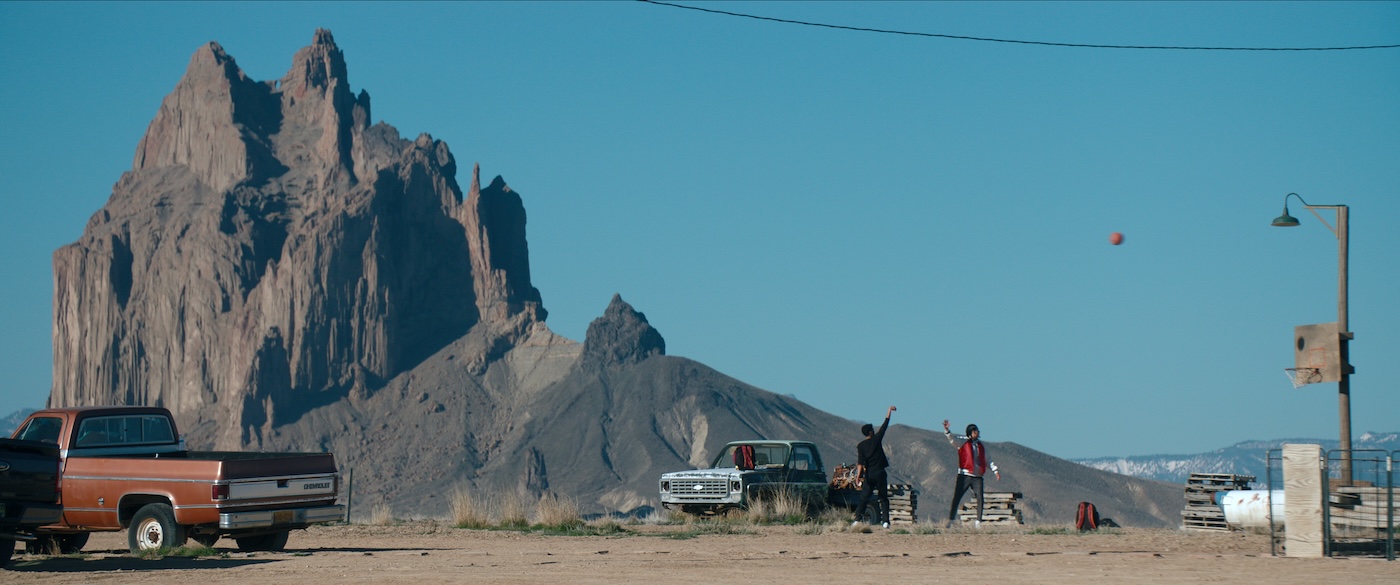
Sydney, you grew up on a reservation in New Mexico. How did the film come about?
SF: I was approached in 2019 by a production company,Wise Entertainment, that had purchased the rights to a series of New York Times articles by sports journalist Michael Powell. They were informative and well-written, but it was an outside-in perspective. When I paired up with Sterlin [Harjo] to write this story, we wanted to tell it from an insider’s perspective. I grew up on the reservation and played basketball, although I was not very good. But I did play. [Laughs.] The scene in the film where Benny Begay (Ernest Tsosie III), the assistant coach, gathers all the players at mid-court and “smudges them” for a Native protection ritual, would have not been uncommon for kids growing up on the reservation. On a lighter note, I remember our basketball team driving to a district championship game and our bus blew a tire and broke down. Our coach had everyone circle up outside the bus, on the highway. He starts smudging us up, as he says, “The rival team put a hex on us that caused our tire to go flat, so we need protection. Bless yourself, bless yourself. And we’re all looking at each other, like “this is serious stuff.”
You mentioned the ingenuity of your art department in matching the early plate work. Any other examples of their contributions?
KK: One story beat I love is when Gloria tries to get to Albuquerque to watch her son play in the championship and never makes it. She’s had multiple DUIs and isn’t allowed to drive off the reservation. So, she ends up being pulled over, arrested, and has to listen to the game in jail, with only the guard in the room. We shot that at one of the gyms we had used for basketball. We blacked out all the windows and had one source from behind her. The jail cell was built near one of the concession stands at The Pit. Production Designer Rich Toyon and his team did a great job with minimal resources.
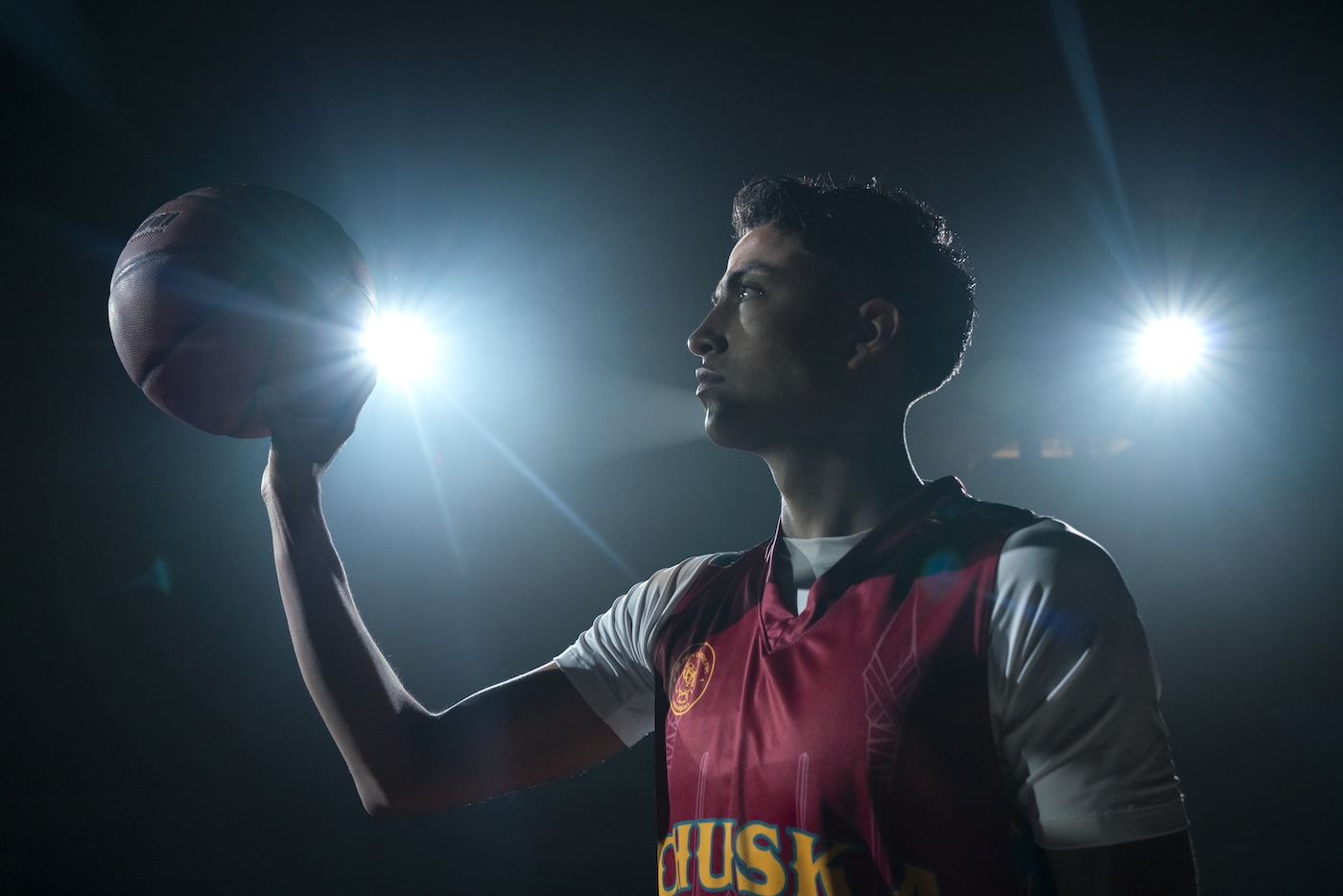
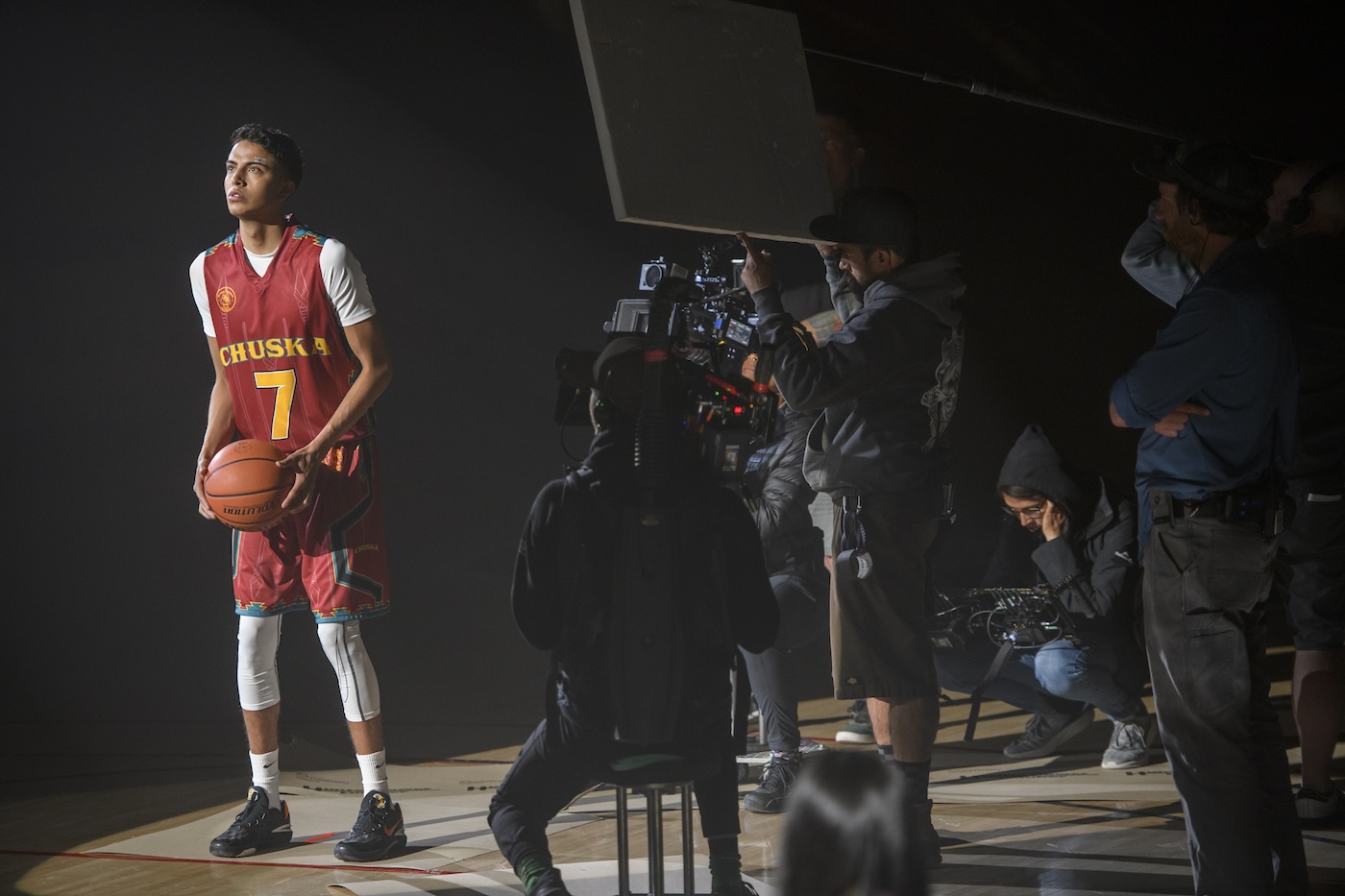
Let’s talk about the championship game. Jimmy’s at the free-throw line with a chance to win – and to dispel the “born to lose” moniker that his mother said comes with life on a reservation. It’s a classic sports film moment, and your choice – freezing time and isolating Jimmy in this empty black space – was different and bold.
SF: On the page, it was always about the juxtaposition of that packed, noisy gym, to this quiet, empty place that puts us inside Jimmy’s thoughts. Talking with Kira, she wanted to keep the approach simple and practical, with this theatrical lighting aesthetic. I loved the concept, but I wasn’t sure how that would look on the day. I remember seeing a lighting demo as all these hard lights popped on, one after the other, and thinking: “Oh, this is way better than I envisioned in my head.” It was a literal and metaphorical spotlight on Jimmy that perfectly suited the moment.
KK: Budget often shapes creativity. And The Pit is a place that does broadcast TV, so all of the existing lighting was what we used to shoot the game. We didn’t add anything, even with the 120 slo-mo stuff, as the rigged lighting in the arena was plenty bright. I had to figure out a way to create this theatrical, dream-like moment, without a lighting package in a massive space. I thought of the introductions to an NBA game, when the lights go down and the moving spots are roaming the court as the players are introduced – it’s very theatrical. We figured out where every camera position was, both in the game and for this moment with Jimmy, which would allow Sydney to cut seamlessly between the two. This all happens between each of his three free throw shots. We also had to light this space where his mom, Gloria, comes out and is sitting in her folding chair – like we see her do earlier in the film outside their house on the reservation, watching Jimmy practice. It was a fun problem to solve – how do you make it so different but not distracting? I was happy with the results we got.
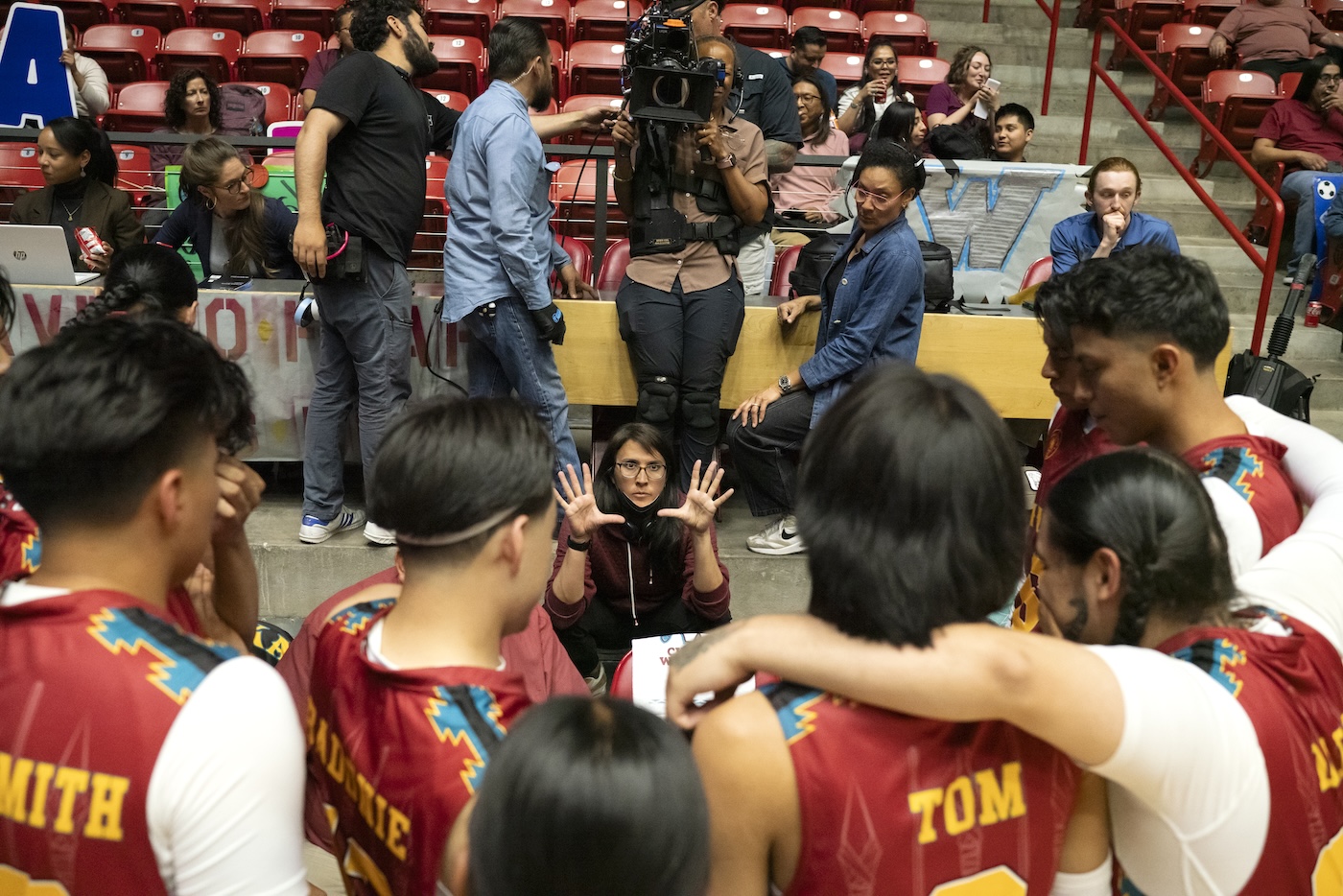
ICG: You shot anamorphic, which makes sense for New Mexico. But that also had the potential to make it more difficult for Kira with the basketball coverage.
SF: The 2:39 aspect ratio lent itself to this horizontal frame. And growing up on the reservation, I wanted to remind viewers that this is [the characters’] whole world. More often than not, you’re presented with a limited set of possibilities. That’s what Nataanii’s going through, and Jimmy’s mom. These vistas may suggest an endless horizon, but if you grow up with limited resources, it can also feel suffocating – the desert and mesas go on forever, and there’s nothing out there. What goes hand-in-hand with that is the overwhelming quiet and stillness of the reservation. We had a scene where Coach Hobbs is running by herself with Shiprock in the background, and she stops to take it in. And I would have sat on those quiet shots even longer if we’d had the time and resources. Growing up, that stillness can feel stifling, but coming back onto the reservation as an adult, it can feel very peaceful. Kira reminded me of that, when we did a location scout, just the two of us. She said: “Wow, it’s so quiet here. I can actually hear my thoughts.”
KK: It’s hard in prep to get any time with the director, and the Shiprock reservation where we shot was four hours away from Albuquerque. We had one day together, to see where the sun was setting, to see the reservation, basically the location where we would shoot Nataanii’s funeral. There was an added expense to shoot on the reservation, so every moment we were there had to be maximized. That scout Sydney and I had was so important in so many ways.
Shooting anamorphic these days means several options in glass – what did you choose for lensing and why?
KK: We shot with the ALEXA Super 35, which I had only used before on commercials, and I fell in love with it on this movie. I used the C-Series primes from Panavision, and those were an amazing fit with all the flares we were playing with. There was no need for any filtration. I also used this Panafocal lens, which was very similar to the C Series, which enabled us to get some great B-roll. I would usually send out our B-Camera Operator Rochelle Brown for that. That was our narrative package. To your point about how shooting anamorphic affects the interior basketball footage, it was a challenge. I used an anamorphic 10-to-1 zoom for the wide/far basketball footage. And since I knew we’d be doing handheld/stabilized rigs on the court, we would need some lighter-weight zooms. I used three Panavision VA spherical zooms for that, and Mike Carter at Panavision helped me get these anamorphic flare adaptors that Dan Sasaki had made. I didn’t care as much about the flaring aspect with the basketball scenes, because we were shooting in these bright, top-lit gyms. But the adaptors gave an anamorphic feeling to the edges, which made the cuts from anamorphic to spherical smoother on the eyes.
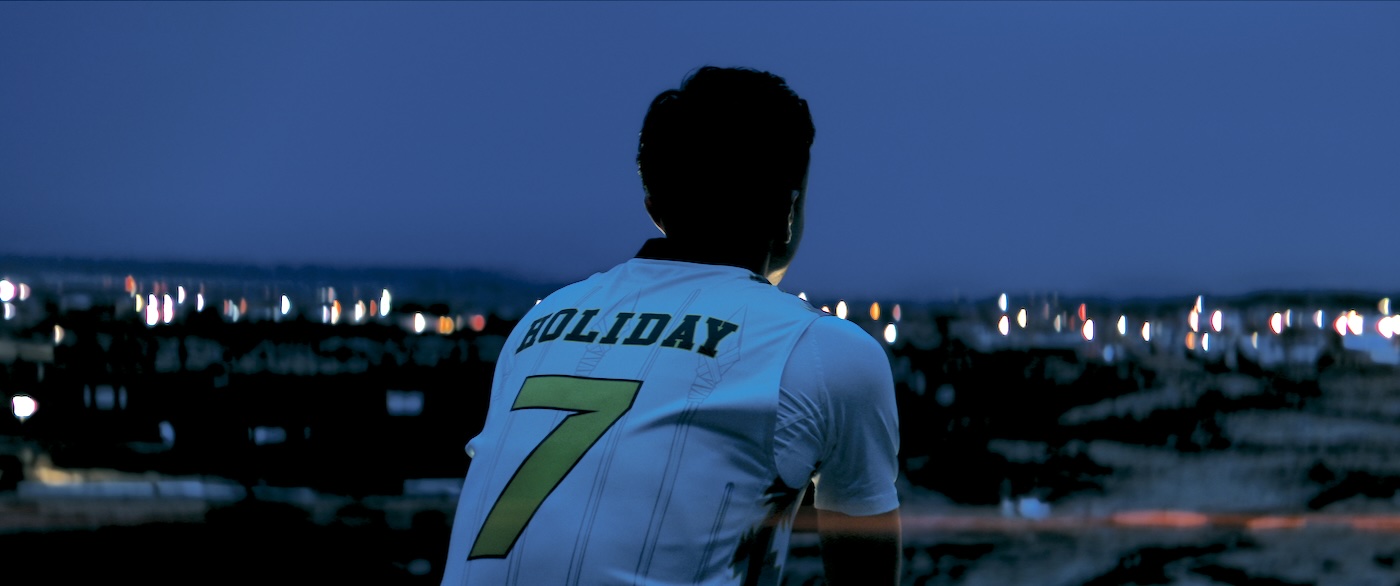
Kira is a big fan of still photography, particularly when she’s on location. Did that factor into this project by helping you visualize her intent?
SF: [Laughs.] She was constantly sending me stills. To go back to the earlier part of this conversation, it was very much “yes and…,” with her stills inspiring more conversation. That advance dialogue is so important because you do not want to be figuring everything out on the day, and the stills help to spark ideas back and forth.
One key location is the mesa the boys go to after the first game, and Jimmy revisits it several times after Nataanii’s death. Were you able to light that, or was it just practicals from the reservation below?
[Both laugh.]
SF: That makes us feel really good.
KK: …because that was an LED screen! On that scout with Sydney, we found a place that we wanted to be the backdrop, and a crew went out and shot plates at that spot. Rich Toyon built a cistern set in a volume stage that Netflix has in Albuquerque. So we had dusk for as long as we wanted. We had a limited number of days shooting on the reservation to stay within our budget. To maximize those days we had on the reservation, we shot a lot of plates and then brought them back to the Volume, where time was not as much of a factor.
SF: If I had had my way, the entire movie would have been shot on the reservation. There was a lot of back-and-forth about how much we could do there, mainly having to do with the tax incentives.
KK: We brought the rez to where we were – for some of those key scenes you mentioned. All of the scenes outside Jimmy’s house when he’s practicing, all of the funeral scenes, anything with Shiprock [Mountain] – those were all shot on the reservation, and I think Sydney’s point is that shooting on Native land brought something very special to the story.
What are your favorite moments from the movie that tie back into that?
KK: The sequence right after Nataanii dies. Visually, the movie gets very quiet, and we get to see those kinds of images Sydney and I scouted that one day on the reservation. The whole cast was there, and we were waiting for the sunset to fall at Shiprock. It’s where I think the C-Series lenses just sing – you can shoot into the sun and have it look…magical. The funeral scene, also shot on the reservation, was another day that was so special. The colors were incredible. It’s a sad sequence, but it was so lovely. And, of course, what Sydney mentioned when Benny is smudging the boys up on the court. I love how each boy has a different way of gathering in the sage smoke. The whole crew got into it as well, and we were smudging up each day. It’s a sacred action, and that visual resonated with all of us making the movie.
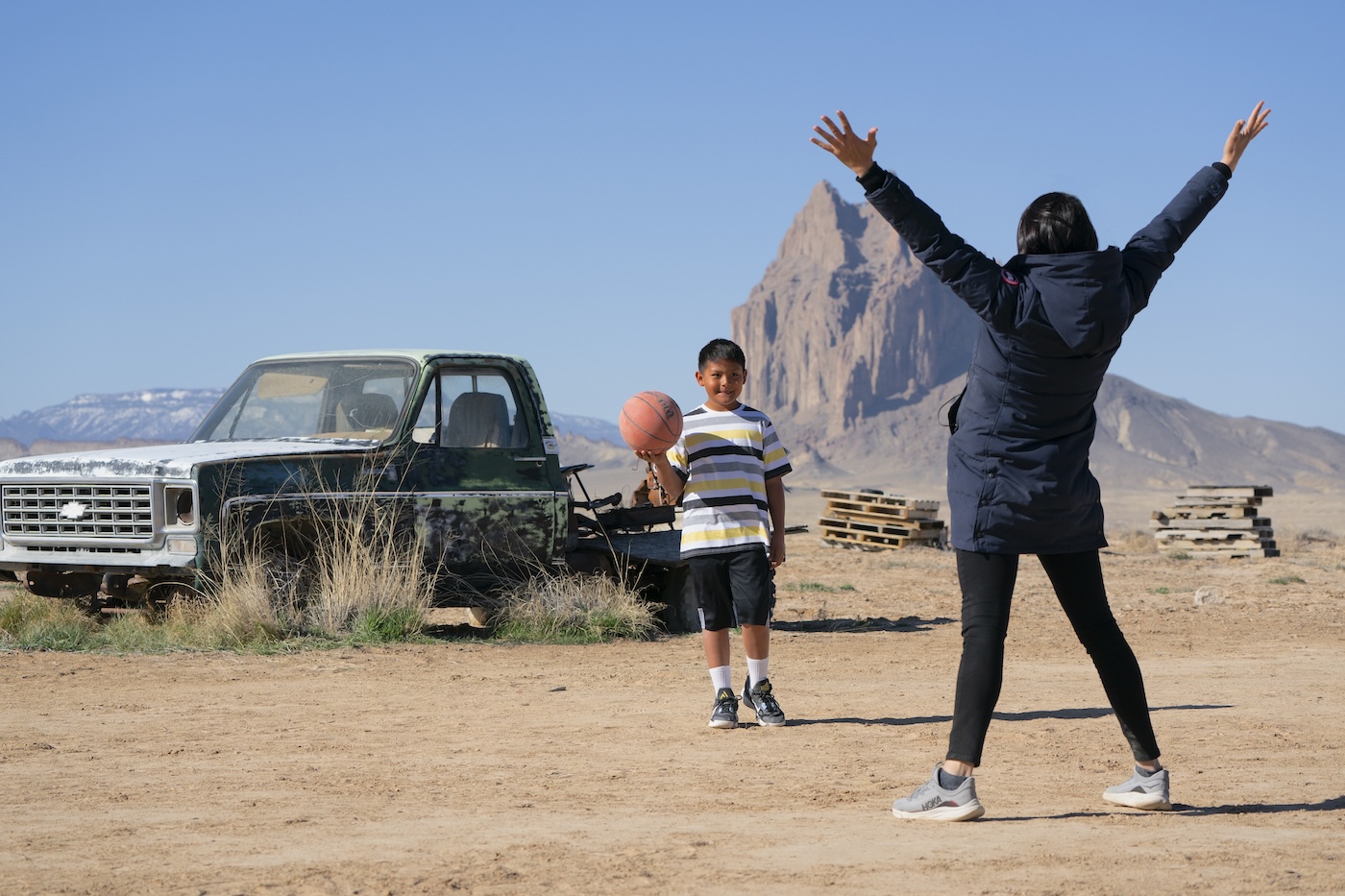
Local 600 Crew – Rez Ball
Director of Photography: Kira Kelly, ASC
A-Camera/Steadicam Operator: Justin Browne
A-Camera 1st AC: Ethan McDonald
A-Camera 2nd AC: Oscar Cifuentes
B-Camera Operator: Rochelle Brown
B-Camera 1st AC: Kingslea Alexis Bueltel
B-Camera 2nd AC: Royce Leii
DIT: Danny Hernandez
Loader: Jordan Graham
Digital Utility: Elleott Herrera
Unit Still Photographer: Lewis Jacobs
